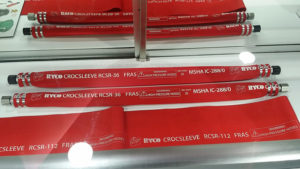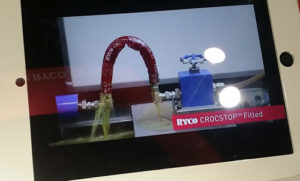 A resounding theme at IFPE 2017 this week has been talk about safety. With high-pressure hydraulics, one must always think about the dangers presented, particularly with hose, when fluids can escape and cause leaks and even cause a hose to burst, creating dangerous hose whip.
A resounding theme at IFPE 2017 this week has been talk about safety. With high-pressure hydraulics, one must always think about the dangers presented, particularly with hose, when fluids can escape and cause leaks and even cause a hose to burst, creating dangerous hose whip.
That’s why one of the most prominent displays at Ryco Hydraulics, booth S81930, was its CrocStop system, said Sean Babbage, General Marketing Managing. The company’s hose protection devices are constantly being tested at Ryco’s test bench facilities to ensure they will keep hoses from breaking free during a high-pressure hose burst.
CrocStop consists of several key components, including the CrocSleeve, a densely woven, polyamide tubular sleeve which contains fluid spray and leakage in case of breakage. It is available in either black or red and is not affected by exposure to air, water, hydraulic oil and many other fluids. This abrasion-resistant design also protects hose from wear which can lead to premature failure.
 After inserting the hydraulic hose into the sleeve, users install the two-section CrocStop cuffs around the hose ferrule and secure the two halves. The main purpose of this device is that if a hose bursts or separates from the fitting, it will contain the hose in the CrocSleeve, ensuring that the initial burst is suppressed and contained within the sleeve. Additionally, the cuff prevents contamination, such as debris and dirt, from entering the sleeve.
After inserting the hydraulic hose into the sleeve, users install the two-section CrocStop cuffs around the hose ferrule and secure the two halves. The main purpose of this device is that if a hose bursts or separates from the fitting, it will contain the hose in the CrocSleeve, ensuring that the initial burst is suppressed and contained within the sleeve. Additionally, the cuff prevents contamination, such as debris and dirt, from entering the sleeve.
Babbage showed a demonstration of how the system works. In a video showing Ryco’s testing of the system to a burst pressure of 9,000 psi, it’s clear to see the hose has ruptured inside the sleeve and fluid leaks out rapidly. But without the sleeve, the hose break sends pressurized fluid spraying everywhere and the hose to whip around wildly.
The compact CrocStop is easily retrofitted to existing assemblies and be used with RYCO’s complete coupling range.
See the CrocStop at Ryco’s booth S81390.
Ryco Hydraulics
www.ryco.com.au
Filed Under: Hose Assembly Tips